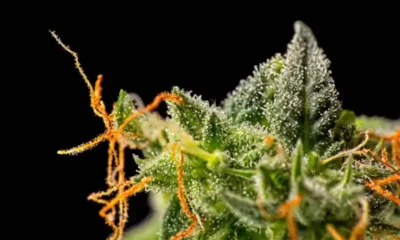Connect with us
Published
1 year agoon

Despite the many opposing arguments against legal cannabis centering the potential dangers to youth as cannabis becomes more accessible, new data on teenage cannabis use deems that the kids are indeed alright.
According to data provided by the U.S. Centers for Disease Control and Prevention (CDC), the percentage of high school students who report regularly consuming cannabis has fallen steadily over the past decade. This is especially notable given that the first states to legalize cannabis did so just over 10 years ago.
The CDC report, Youth Risk Behavior Survey Data Summary & Trends Report 2011-2021, dives into a variety of topics, from sexual behavior, substance use, experiencing violence, mental health and suicidality. Regarding substance use in 2021, high school students were more likely to currently drink alcohol (23%) and currently use an electronic vape product (18%) than to currently use cannabis (16%). Current use is defined as use within the last 30 days.
According to the report, cannabis use has seen a steady year-over-year decline among high school students, with 23% reporting current use back in 2011.
Looking closer at demographic information, female students were also more likely than male students to use cannabis. Black and multiracial students were also more likely than Asian, Hispanic and white students to currently use cannabis. LGBQ+ students, or students with any same-gender partner, were more likely than their peers to currently use cannabis as well.
Paul Armentano, deputy director for the National Organization for the Reform of Marijuana Laws (NORML), highlighted the positive message this data sends about the industry as a whole in a recent blog post.
“These latest findings add to the growing body of scientific literature showing that legalization policies can be implemented in a manner that provides access for adults while simultaneously limiting youth access and misuse,” Armentano said. “Furthermore, these findings stand in sharp contrast to the sensational claims often made by legalization opponents, claims that thus far have proven to be baseless.”
If you feel like you’ve seen similar findings in the past affirming the same decline in youth cannabis use, you’d be correct. The findings are consistent with numerous other surveys showing the declining rates of cannabis use by young people, as states across the U.S. steadily began legalizing cannabis over the same period.
Another CDC report released in 2020 assessed substance use patterns among high school students from 2009 to 2019, and while there was a temporary uptick from 2009 to 2013 in self-reported cannabis use (which was notably before any states enacted adult-use legalization laws), this was followed by a decrease from 2013 to 2019.
Additionally, a 2020 study published in the Journal of Adolescent Health similarly concluded that regulating the use and sale of cannabis for adults is not associated with an uptick in cannabis use by young people. The study used data from the Youth Risk Behavior Survey from 47 states, this time from 1999 to 2017, to assess cannabis use, among other substances.
“Results suggest minimal short-term effects of RML on adolescent substance use, with small declines in marijuana use,” authors concluded.
In 2021, the National Institute on Drug Abuse (NIDA) Director Nora Volkow also acknowledged that, while she expected cannabis use among adolescents to rise when states began to legalize cannabis, “overall it hasn’t,” she said, calling reform advocates “right” about the impact of the policy change on youth.
These are just a handful of examples among a much broader group of studies and data affirming that indeed, cannabis legalization has not led to an increase in youth use. As more states continue to look ahead at recreational cannabis laws and policy, cannabis opponents might need to find another argument.


Despite City Efforts, Hemp Shops Posing as Dispensaries Prevail in Las Vegas


Cannabis Community, Investors React to DEA Decision To Reschedule


Georgia Governor Signs Bill Establishing Licensing Requirements To Grow Hemp


Study: Psilocybin Enhances Meditation


Ohio GOP Lawmakers Debate Adult-Use MJ Priorities, Eye June for Regulation Approval


Taylor Swift Puts Narcotics Into All of Her Songs on ‘The Tortured Poets Department’
